#also Aang is plural or a system?
Text
Hey so Avatar Kyoshi can just physically manifest & take the wheel at any time? That feels kind of over powered??

We’re just not gonna talk about how Kyoshi possessed Aang? 👀
Also feels like the avatar detection statues in Zuko’s ship got retconned already. Iroh asking how Zuko knows he’s on the right path to find the Avatar but neither of them acknowledge the avatar tracking statues that this adaptation spawned in. 😩 It was a little frustrating to watch. Either leave them in & acknowledge them or just leave them out.
#my partner speculated that 2 different writers were trying two different things at the same time which made the scene with Iroh & Zuko very#jarring when the avatar state detection statues weren’t acknowledged#also Aang is plural or a system?#good for him!#also I feel like Kyoshi would have been more merciless but it seems like she was on a limited power budget?#still felt over powered af that she can just... do that#like oh my god; also gender fluid Aang headcanon?? gotta be feeling something strange after turning into a cool warrior lady#I don’t remember this ever happening in the show#I’m pretty sure Aang never got transformed into Kyoshi against his will lmao#Netflix avatar is such a wild adaptation#mine#op#avatar live action#avatar the last airbender#atla#natla
32 notes
·
View notes
Text
The Plurality of... Avatar: The Last Airbender
Major Spoilers For Avatar: The Last Airbender ahead! And minor spoilers of related properties.
Water. Earth. Fire. Air.
Long ago, the four nations lived in harmony. Then everything changed when the Fire Nation attacked. Only the Avatar, master of all four elements could stop them. But when the world needed him most, he vanished.
Welcome to the world of Avatar: The Last Airbender. A world where some people are born with the gift of bending, an ancient art that allows them to control one of the four elements. But only one. Even if they came from parents who were different types of benders, each bender only gets a single element.
But there exists a single exception to this rule. The Avatar. The one person in the world who can master all four elements.
But we're not here to talk about the Avatar's cool bending powers. We're here today to talk about…
The Plurality of The Avatar
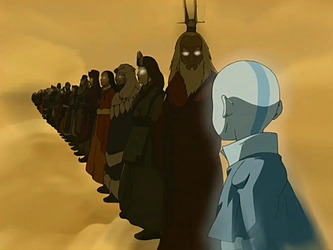
Plurality: A state of multiple self-conscious agents, or "headmates," sharing a single body.
The Avatar isn't merely a jack of all trades bender. Simply knowing how to use the four elements is only a small part of their toolbelt. And perhaps one of the least important. Despite the series placing a strong focus on the need to master all four elements, perhaps the actual most important thing about the Avatar is that they reincarnate and are connected with their past selves.
This allows each Avatar to speak to and learn from the experiences of past avatars. This is most prominent in what's called the Avatar State, a sort of super form where their eyes (and downvotes) glow as they channel the skills and abilities of all the past avatars through them.
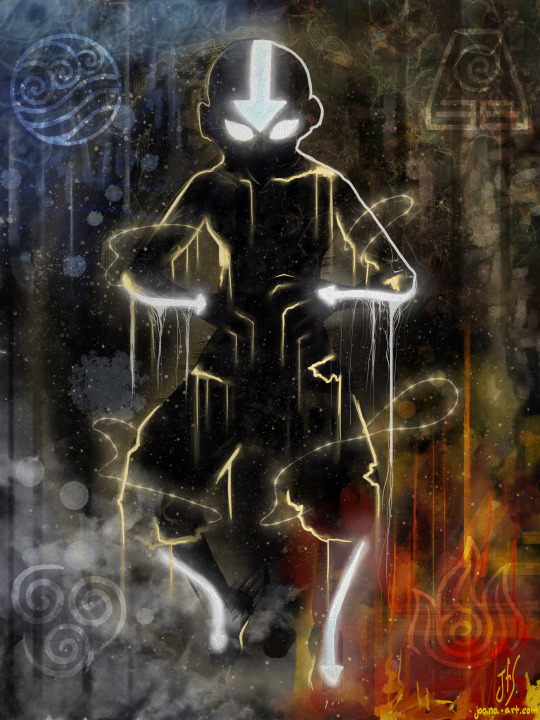
(Art by @joeyscomics)
Aang's avatar state is a sort of blending of the avatars without a distinct identity of its own.
Additionally, there were also a couple instances through the show where Aang, the current avatar, switches into other avatars.
During the season 1 mid-season finale, The Winter Solstice, Aang first contacts Avatar Roku, his firebending predecessor. Trapped in a temple with no way out, a group stands outside the door prepared to strike as soon as the avatar steps through. They expect to see a small child walk through the doors. But what they see instead is Avatar Roku.

Once the enemies have been defeated and fled, Roku turns back into an exhausted Aang, who drops to his knees.
In season 2, this happens again with Aang switching into avatar Kyoshi. Again, sure to spirit magic, Aang physically transforms into Kyoshi.
(Obviously, real plurals don't physically transform, as cool as that would be. But spirits in the avatar universe do have shape-changing capabilities, being able to alter both their own forms and the forms of others. There are many examples in Legend of Korra and the comics, but one big one we see in A:TLA is Koh The Face Stealer, who as you can guess, steals people's faces, physically transforming their bodies. Simply put, we can accept the Avatar Spirit as having the ability to naturally shapeshift.)
So there's the basics of the Avatar's plurality. We have multiple people sharing a body. We have system-like internal communication. We have switching. And we even have a state that could be best described as blendy.
In the plural community, a system that's formed from past lives is sometimes called Fenigenic or Phoenigenic, drawing its name from the phoenix; The mythical bird that dies and is reborn from its ashes.
From Pluralpedia:
Fenigenic is a system origin that describes systems who formed from past lives in some way.
They may believe they left their past life and were reborn again as a system, came into the system from a past life into the body (causing plurality), were a system in a past life and were reborn again with the same one, and/or various other scenarios. This is an intentionally broad label that can describe many different experiences.
With these established facts, without a doubt, the avatar would qualify as a Pheonigenic system.
But I want to delve even deeper. Because at its core, Avatar: The Last Airbender isn't just a story about a kid who happens to be plural. It's a story about plurality. It's a story about dissociation. About connecting with and building connections with parts of yourself. And about taking responsibility for those parts, even when you aren't actually them. And all of this is what make the series so fascinating from a plural perspective!
The Avatar State as a "Self-Defense Mechanism"
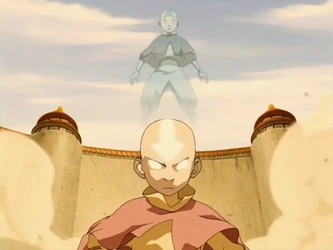
At the beginning of season 2, Aang enters the avatar state while scared of losing his friends, and talks to Roku again. Roku explains to Aang what the avatar state is.
The Avatar State is a defense mechanism, designed to empower you with the skill and knowledge of all the past Avatars. The glow is the combination of all your past lives focusing their energy through your body. In the Avatar State, you're at your most powerful... but you are also at your most vulnerable.
At this point, Aang learns that if he dies in the Avatar State, the cycle breaks and the avatar will never reincarnate again.
Let's take another look at that wording though. "The Avatar State is a defense mechanism." It's a word choice that you wouldn't expect to find in a fantasy cartoon. "Defense mechanisms" are more a psychological term, having their origins in psychoanalysis.
Why does this matter?
Because the avatar state, at its core, is a dissociative state. And dissociation has often been described as a defense mechanism itself. From Wikipedia:
In mild cases, dissociation can be regarded as a coping mechanism or defense mechanism in seeking to master, minimize or tolerate stress – including boredom or conflict.
And later when talking about traumamatic dissociation, it goes on to explain:
Symptoms of dissociation resulting from trauma may include depersonalization, psychological numbing, disengagement, or amnesia regarding the events of the abuse. It has been hypothesized that dissociation may provide a temporarily effective defense mechanism in cases of severe trauma; however, in the long term, dissociation is associated with decreased psychological functioning and adjustment.
What's interesting about the avatar state is that, while there are some times Aang goes into the Avatar State to protect himself, often he enters it as a response to stress in general.
The first couple times we see Aang go into the Avatar State, it's to physically protect himself. Once to freeze himself. Then again to fight Zuko. But the next time he enters the Avatar State, there's no danger. There's no need to use it.
This is when he's at the Southern Air Temple, and sees his old friend Monk Gyatsu. It's when he really learns and has to process that he's the last airbender and everyone he ever knew is dead.

Aang doesn't use the avatar state as a physical defense mechanism here. Rather, he enters the avatar state as a psychological defense mechanism.
It takes over because he's disengaging. He just learned something traumatic and he can't come to terms with it. He shuts down, and his friends have to reach him through the pain.
This becomes a pretty common theme throughout the series from then on. Sometimes, it's the physical danger that causes him to transform. But other times, he's triggered into this state by his friends being in danger, or from losing Appa.
Time and time again, we see the Avatar State as being triggered by extreme mental stress more often than by any sort of physical stress.
A big part of Aang's journey though the series then becomes learning to master the Avatar State and the dissociation that comes with it. To take control of it instead of letting it control him.
Avatar's Take on System Responsibility
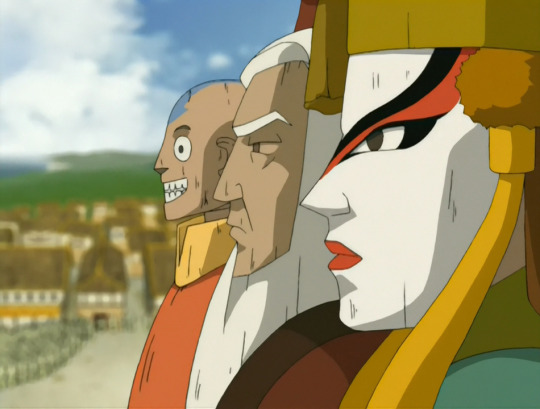
"System responsibility" is the concept in the plural community that if one headmate does something, then the entire system of headmates is responsible for it. Some feel this is unfair, but for practicality, it makes sense. If someone steals something, then obviously you can't send only one headmate to prison. So a big part of being plural ends up having to accept that if someone else you share a body with does something wrong, even if you don't agree with it or don't even remember it, you're responsible for it.
And Avatar has its own form of this, where all Avatars have a single spirit that is reincarnated, and are therefore responsible for the actions of their past lives.
This is most exemplified in the episode Avatar Day.
In this episode, the Gaang wander into a town that's celebrating the titular Avatar Day. They see a parade with massive wooden floats of the past three Avatars. Aang, Roku and Kyoshi.
What appears to be a nice festival that the Gaang is enjoying is quickly turned on its head when a villager sets fires to the figures and the crowd begins chanting "down with the Avatar" while the figures burn.
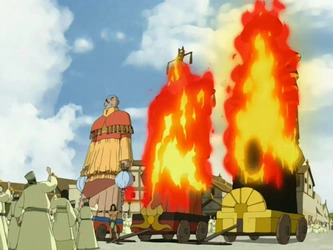
It turns out, this town believed Avatar Kyoshi murdered their leader, Chin The Great.
In order to prove he wasn't a murderer, Aang volunteers to stand trial. Even though Aang and Kyoshi are separate people in a way... in another, they aren't. And Kyoshi being a murderer is something that would continue to follow Aang around.
So he agrees to go on trial, and refuses encouragement from his friends to escape. And he could escape if wanted to.
When viewed through the lens of a plural system, what we see here is a demonstration of system responsibility, where Aang is showing himself willing to take responsibility for the actions of past Avatars.
Later in the episode, Katara decides that they need to call Kyoshi herself to prove their innocence, and dresses Aang in Kyoshi's clothes to "see if it might trigger something."

And it actually does! This stunt causes Kyoshi to take front! (With a full body transformation because spirit stuff.)
In the end, Kyoshi confesses to killing Chin, who she calls Chin the Conqueror, and Aang is willing to accept the outcome of the trial.
It's not just this one episode though. It's a running theme of the series.
The franchise even.
In season 3, Roku reveals that the whole reason the world was in danger was because of his connection to and weakness in stopping Fire Lord Sozin, who went on to wipe out the Air Nomads. Aang is left with the responsibility of making up for Roku's mistakes.
In the books, it's revealed that Avatar Kyoshi's earliest trials were a direct result of the failings of Kuruk, the avatar before her. And his were a result of Yangchen's mistakes. And in the sequel series, avatar Korra is left to make up for the mistakes of not just Aang, but also Avatar Wan who started the cycle.
The Avatars are people who share a single soul. Each new avatar can be viewed as a new host in the same system. And each one therefore is responsible for making up for the mistakes of those that came before.
This is what the avatar franchise, at its core, is about. A single system making mistakes through life after life, and having to fix those mistakes in the next, hopefully making the world a better place and keeping balance along the way.
A Story of Connection and Balance
With all of this in mind, Aang begins his journey is a system cut off from his headmates.
A central theme of the story is restoring that connection. This story really begins with Aang entering the avatar state in the Southern Air Temple. This is the first time he loses control and nearly hurts the people he cares about.
The avatar state here is something powerful, yes, but also something to be feared, making him a danger to his friends. He doesn't understand at the time what that state is exactly. It's something that leaves him confused and scared.
Through the series, he gradually learns more about the avatar state and his past lives. He begins to learn from avatar Roku. Then from Kyoshi. He learns about their lives, and has to reconcile their past mistakes. He also has to learn to accept himself as the avatar. Something which he struggled with throughout the series, and led to him fleeing his people.
At the end of season 2, Aang nearly dies in the avatar state. In a canon webgame called Escape from the Sprit World, while unconscious, Aang enters the spirit world and goes on a journey where he has to reconnect with the past avatars in order to prevent the avatar cycle from being broken, going back all the way to meet Avatar Yangchen, the airbender before him.

After meeting and learning from all these avatars, he's able to awaken with a new connection to them. (Albeit with no memory of this side quest.) Although he's told he won't be able to enter the Avatar State for the time being.
After this, on the Summer Solstice, he was able to meet with Roku once again to learn about Roku's own past, and his history with Fire Lord Sozin.
All of these events laid the groundwork for a final realization in the series finale. That the past avatars were always with him. He's able to meditate and reach out, and commune with each of them.
Finally, Aang has become a fully-realized avatar, tearing down barriers that kept him separate from the rest of his system!

And in the final battle, Aang is able to access the avatar state with full control over it for the first time.
Some would say that this was because of a conveniently-placed rock. Which, yes, that might have been the literal trigger that unblocked his chi. But narratively, I would argue that it was the connection with the past avatars that truly allowed him to access the avatar state again. That finally connecting with them all was how he truly earned this ability!
Conclusion
So there we have it! The story of Avatar: The Last Airbender is not just an incredible story, but an incredible story of plurality and connection between headmate.
This was really fun to write about, and I enjoyed talking about the plurality of the Avatar.
Thank you so much for taking the time to read!
I think with that, I've covered everythi...
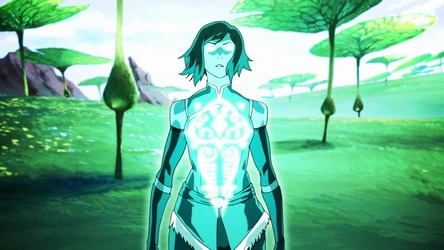
Oh... right...
I guess I didn't cover everything about the plurality of the Avatar, did I?
Guess I need to plan for a Plurality of The Legend of Korra in the future! 😁
(And if you're interested in more of my ramblings about plural representations, you can check out my post about the Plurality of Batman. Or you can read about The Plurality of The Hybrid Chronicles: What's Left of Me, where I analyze a novel about a world where everyone is born with two souls.)
#pluralgang#avatar the last airbender#atla#aang#a:tla#avatar state#avatar aang#the last airbender#avatar#avatar last airbender#nickelodeon#plural#plurality#endogenic#pro endogenic#pro endo#sysblr#system stuff#plural representation#actually plural
163 notes
·
View notes
Note
switchin it up a bit!! I want to suggest; AANG from atla!! I personally dont think hes a system, but i can see how they would see him that way! The avatar state is a state of dissociation and aang geta blackout amnesia and doesnt remember what he does when hes in that state. And also hes multiple people in one body!! kind of.
[saw someone make that argument... which like. okay. but those are just him, its a psiritual thing, not a system thing, he believes that those are his past lives, and those are cANONICALLY his past lives in the show? like they have a whole spiritual reason for his "systemness", but we want to know what YOU think about it :3]
-🌀sys (blurry, probably richie)
!!

(this image is so small T-T im so sorry aang,,)
from what i know and have been told, i agree with you guys ! this reads a lot more as a spiritual Actual Past Life thing rather than a plural thing, plus adding on further; if i remember correctly he was only able to talk to one? of them?? like the previous avatars don't know him and never have and never will and aren't really in his brain more so in his soul? sort of.
(FULL DISCLOSURE: i haven't actually watched atla myself, but we have watched several Several video essays over-analyzing the show as a whole, and so that is where this view is coming from)
Rating: Not really plural, but theres something there for some systems to relate to !
#mod 💜#this is reminding me i must watch more shows that only i like#and not 🦉's likes#didosdd#did#osdd#osdd system#endos dni#anti endo#plural#plurality#plural system#did system#actually dissociative#complex dissociative disorder#dissociative identity disorder#actually osdd#did osdd#osddid#actually did#🌀 sys anon#plural rating
6 notes
·
View notes
Text
r/systemscringe is upset about Deku being plural! 🤣


Oh no! I've offended the fakeclaiming subreddit! Whatever shall I do! 😲 /s

I mean, yeah. They even literally switch in one episode!
youtube
Katara dresses Aang in Kyoshi's clothes to try to "trigger" something and then Kyoshi takes over the body.
Each past life is essentially its own headmate separated by extreme dissociative barriers, and then blend together whenever they enter the Avatar state.
This would specifically be a Fenigenic system.

Also, the bending is largely unrelated to the plurality. The bending is a gift from the lion turtles but it's likely that the connection to their past lives is more a result of their bond with Raava. (Who is another headmate outside of the past lives.)

Nah. I've had the Avatar one in mind for well over a year. 🤷♀️

Spiritual plurality is the oldest form of recorded plurality, and most fantasy and supernatural plurality has roots in spiritual plurality, so it's hardly a contradiction.

Hey, thanks for introducing me to that! 😜
Honestly though, while plural adjacent, it sounds like the symbionts just instantly fuse with the host.
So despite being two separate beings sharing a body, they're functionally a singlet?
Though, this is just what I'm picking up from reading an article. Maybe there's more plurality to them in the actual show than I'm giving them credit for.
#syscourse#star trek#avatar the last airbender#my hero academia#boko no hero academia#pro endo#pro endogenic#plural#plurality#endogenic#multiplicity#endogenic system#r/systemscringe#systemscringe#the last airbender#aang#deku#mha#sysblr#actually plural#Youtube
184 notes
·
View notes
Note
A new angle on plural headcannons: When there's a character that only ever talks to one other character, gonna say that's plural.
Like the example that comes to mind (but might need verified with a re-watch) is the cat in Coraline. If our recollection is right, I believe the cat only ever talks to Coraline. The cat is Coraline's headmate and does projection (perhaps onto a physical cat).
Oh also, gonna throw in the Aang and Korra from the avatar series if it hasn't already been mentioned.
-Faye
Yes! I think you're right about the cat not talking to anyone else.
It did interact with others, but I don't remember it talking to anyone else. I can totally get on board with the idea of a headmate that was inhabiting the cat.
Oh, and for the Avatar, absolutely!
There's a type of headmate referred to as a Reincarnitive that fits this perfectly.
And it's not even just voices either. The Avatar State is basically all the Avatars co-fronting at once and blending together.
And Kyoshi even switched in herself during one episode!
youtube
In short, yeah. The Avatar is totally an endogenic system!
#endogenic#atla#atla aang#syscourse#avatar: the last airbender#the last airbender#avatar the last airbender#coraline#pluralgang#avatar#reincarnation#plurality#pro endo#pro endogenic#plural#systems#multiplicity#endogenic system#plural system#system stuff
33 notes
·
View notes
Note
I don't know that much about tulpamancy, does that mean you have littles and adults too? I'd love to learn!
Welcome!
We actually have two minors in our system. We don't use the word "little" since that doesn't feel right for them. They were fictives who were meant to be child protagonists. Calling them "littles" feels like calling Luz or Aang fictives littles. They're kids and identify as kids, but they're also an adult's interpretation of kids made for a fictional setting, which makes them more confident and less naive than most actual children.
I would contrast this with many DID littles that are created during childhood and just don't age.
Although you can definitely create tulpas as imaginary friends as children, and then they choose not to age with the body.
I've also heard of headmates in in-system relationships, even some DID systems, creating tulpa children as head babies. Sometimes this is through simulated pregnancy. Once, I heard of a baby tulpa being created in an egg.
All in all, tulpamancy, just like other forms of plurality, is a vast and diverse experience.
#ask box#endo system#endogenic#plurality#plural#endogenic system#plural system#actually endogenic#actually plural#tulpa#system stuff#tulpas#tulpamancy#pluralgang
18 notes
·
View notes